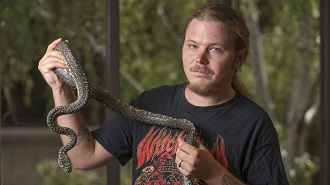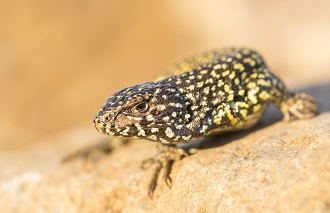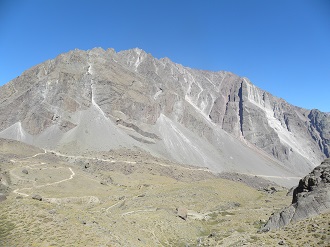Evolution Highlight by Damien Esquerré
Ecology and Evolution, Research School of Biology, The Australian National University
What gave you the idea for this study?
My career as a scientist was kickstarted with Liolaemus lizards, back when I was an undergrad student in Santiago, Chile. I did quite a bit of taxonomy on them, and by doing fieldwork I quickly realised how you would find especially big diversity in the Andes mountains. For me it was obvious how important these mountains were at determining so much about their diversity and biology. The idea is not new of course, and others have investigated this, but I wanted to do it at large scale, make a big phylogeny of the group and test several hypothesis on the effect of these mountains and their uplift.
What was the big question you were trying to ask and why was it exciting?
The big broad question was, how has the formation of the Andes shaped the evolutionary fate of the Liolaemus lizards? This was exciting on many levels, but in particular was my personal attachment to these lizards and also to the Andes, where I grew up.
In what ways does this study expand or build on your previous studies?
It expands on providing a more mechanistic explanation on the patterns I was studying previously, which was the diversity of lizards in the Andes.
From your perspective, what was the most interesting or intriguing aspect of this study?
I think the finding that there might be reversals to oviparity, breaking Dollo's law. I am not saying that definitely happened, but phylogenetic evidence suggests it is likely. I have future research plans to delve deeper into this question, taking a more physiological and histological approach, collaborating with people who have these skills which I don't.
Were there any unexpected logistical or technical challenges you had to address?
Data analysis always presents difficult challenges, and that's why I like collaborating with people who can help with that. In that respect, Ian Brennan and Renee Catullo were extremely good to have on the team.
Did your work take you to any interesting locations? If so, what were they like?
Most of the actual work, like usual, took place in the lab and in front of a computer, but before that I did spend a lot of time doing field work in different locations of the Chilean Andes. It is really cool to be in these places where vegetation barely grows, you get altitude sickness, that are covered in meters of snow during winter, and yet in the summer they are crawling with lizards. The landscapes are just mind-blowing.
Tell us something about collecting these data that people might not know or think about.
Collecting some of these lizards was a real physical challenge, since you actually have to climb mountains to get them. In other cases the roads that lead to some of the locations are quite narrow and scary, and I have feared falling off cliffs in the vehicle a few times.
Did you have to learn any new analytical techniques for this study?
Oh yes, lots of them. Maybe even everything I did in the study I had to learn.
What was the most challenging part of analyzing your data?
I guess running big time-callibrated trees in a Bayesian framework that take weeks and finding the appropriate priors for these is always a bit of a head-ache!
What was your writing process like?
I think it was pretty straightforward, with lots of discussion with my supervisor Scott Keogh and my other co-authors on how to best approach writing together such a variety of different analytical approaches and making it coherent.
What was the biggest challenge about writing the manuscript?
Making very different aspects (phylogeny, diversification, reproductive mode reconstruction) come together into a coherent manuscript.
How did writing up this study compare to previous paper writing experiences?
It was quite fun, I had already written a few papers and had felt like already been through that insecurity about writing and was actually enjoying it, especially because it is a topic I love.
What was the review / revision process like?
You always have Reviewer 2! But kidding aside, the editor and reviewers were very good and constructive and I am really happy with the final product this process produced.
Do you have any writing tips for others?
I like reading and writing simultaneously. I start reading a paper I like and that inspires me and I write little parts and start putting it all together. Might not be the best way, but works for me!
Looking back, what is one thing you learned from doing this study (other than your main findings) that you’ll use in future projects?
How to set up a good team of researchers with different skills and perspective to increase the quality of a project.
What was the most difficult part of this study and / or the most rewarding?
The analysis for me is usually the biggest challenge, since I do not have a computing background. The most rewarding was seeing how much media attention this study got and get to tell about our research to a general public. We even got a poet inspired to write a poem about the study! I like when science leaves the bubble of academia and gets a non-scientific audience excited about stuff they did not know.
How would you explain your study to a five-year-old?
Mountains are very old, but have not always been there. They grow kind of like trees do -- so slow we can't see it during our lives. Thankfully, smart scientists have figured out how old they are. Animals have also been around for very long and have also been changing, through a process called evolution. We found that as mountains have been growing, a particular group of lizards that likes living on them has been changing along with them and thanks to them.


